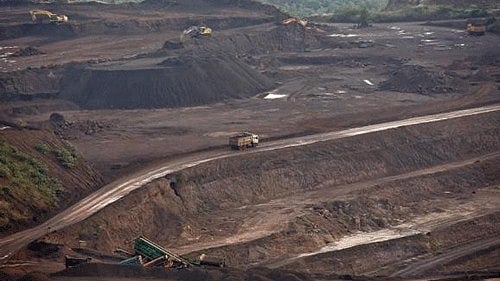
A truck loaded with iron ore passes through the Bedara Bhommanahalli (BBH) iron ore mines at Chitradurga in Karnataka.
Credit: Reuters File Photo
Bengaluru: Amid a plea pending before the Supreme Court to lift restrictions on mining in Karnataka, a KSPCB report has shown that air pollution in mining areas was dangerously high, with the pollutant PM10 exceeding standards set by the Central Pollution Control Board (CPCB) by 20 to 60 times.
Following a direction by the Supreme Court, the Karnataka State Pollution Control Board (KSPCB) submitted a report to the Central Empowered Committee (CEC), which is looking into all matters relevant to a plea by the Federation of Indian Mineral Industrial (FIMI), Southern Region, for relaxation of mineral extraction limits.
As per the National Ambient Air Quality Standards (NAAQS) set by CPCB, the maximum permissible concentration of PM 10 in the core and buffer areas of mining zones is 100 microgram per cubic metre.
The KSPCB monitored the PM 10 concentration in the mines of Ballari, Vijayanagar, Chitradurga and Tumakuru districts. Documents show KSPCB found repeated incidents of breach.
“As per ambient air quality monitoring reports, in most cases, particulate matter (size less than 10 microns) or PM10 values in both core and buffer zones exceed stipulated standard of 100 microgram/cubic metre (the NAAQS notified by CPCB),” KSPCB member secretary S S Lingaraja said in a letter to CEC.
The KSPCB’s monitoring varied, with data for some mines or buffer zones being available, while it was not available for some years for others. However, within available data, there were brazen breaches of the PM 10 standards in core as well as buffer areas of the mines in all 10 years of monitoring. No data was available for other pollutants, especially the smaller but deadly particles (PM 2.5).
On the gaps in data, Lingaraja said the board was monitoring the working mines for air quality once in 3 months by manual method. On the lack of data for other pollutants like PM 2.5, he said, “We are only measuring PM10 in mining and buffer areas”.
Record levels of pollution
Among the biggest breaches was the concentration of PM10 at a shocking 6,102 microgram/cubic metre at Bhomman Iron Ore Mine of JSW Steel Limited in 2022-23, documents showed.
In 2023-24, John Mines (2,448 microgram/cubic metre of PM10), Vedanta (918 microgram/cubic metre), JSW (389 microgram/cubic metre) and others were found to be among those where PM 10 levels were above national standards.
Some mines, both government and private (see box), were found to be repeatedly breaching standards during multiple rounds of monitoring conducted the same year as well as in following years.
For instance, in 2013-14, two mines operated by National Mineral Development Corporation (NMDC) were in breach. While the PM10 levels at Kumaraswamy iron ore were at 421 microgram/cubic metre, they were at 259 microgram/cubic metre at Donimalai.
The Kumaraswamy mine breached again in 2014-25, while Donimalai mine was in breach in 2021-22 too.
To a question on action taken against violators, Lingaraja said, “From time to time, notices and directions are being issued for companies when spikes are observed due to fugitive emissions.”
Advocate Mallikarjuna Reddy of Samaja Parivartana Samudaya expressed concern over the pollutants.
“The data shows KSPCB is not doing its job properly. We are seeing shocking levels of violations. We will request a Supreme Court-monitored evaluation of air quality to expose the impact it has on the people of four districts,” he said.
Forest, Ecology and Environment Minister Eshwar B Khandre said KSPCB had been monitoring pollution levels.
“The Board is regularly monitoring pollutants in 41 functioning mines. I will direct action against highly polluting units,” Khandre told DH.